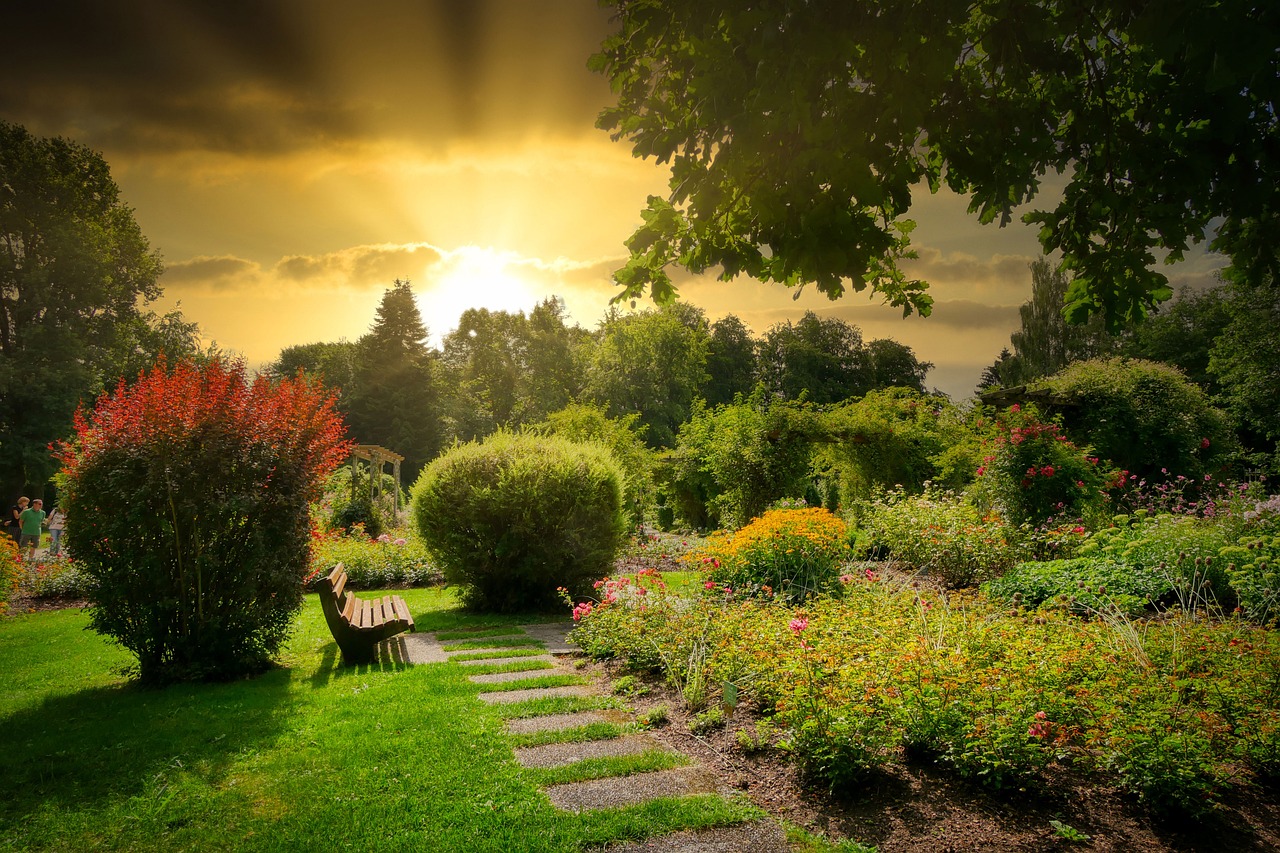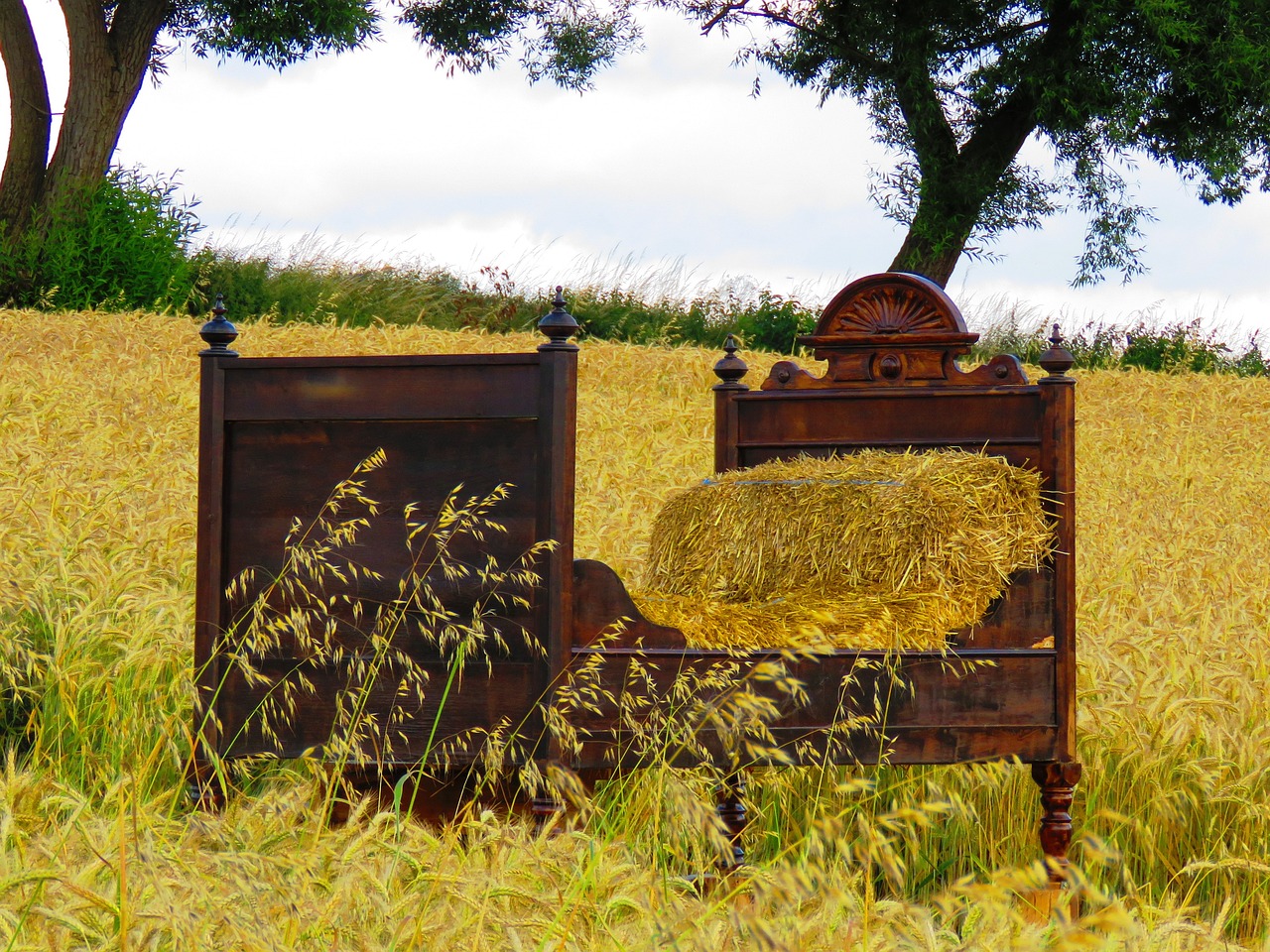What Are Raised Garden Beds and How to Use Them
Raised garden beds are a fantastic way to elevate your gardening game, both literally and figuratively! Imagine a garden space that not only looks neat and organized but also provides you with better control over soil quality and drainage. These beds are typically constructed above the ground level, creating a defined space where you can plant your favorite flowers, vegetables, or herbs. The concept is simple yet effective: by raising the soil, you improve aeration and drainage, which can lead to healthier plants and a more productive garden.
But wait, there’s more! Using raised garden beds can also make gardening more accessible. If you’ve ever struggled with bending down to tend to your plants, you’ll appreciate the ease that these beds provide. They can be built to a height that suits your comfort level, reducing strain on your back and knees. Plus, they can be filled with high-quality soil, ensuring your plants have the best possible growing environment.
Now, you might be wondering, “How do I get started with raised garden beds?” Well, it’s easier than you might think! First, you’ll need to choose a suitable location in your yard that receives adequate sunlight and has good drainage. Next, you can decide on the materials for your garden bed—wood, metal, or stone are popular options. Each has its own unique benefits and aesthetic appeal. Once you’ve built your bed, it’s time to fill it with the right soil mix and start planting!
In addition to being functional, raised garden beds can be a beautiful addition to your landscape. They can be designed in various shapes and sizes, allowing you to express your creativity. Whether you prefer a rustic wooden bed or a sleek metal design, the possibilities are endless!
In summary, raised garden beds are a versatile and practical solution for gardeners of all levels. They offer improved soil conditions, easier access, and the opportunity to create a stunning garden space. So, if you’re ready to dig in and get your hands dirty, raised garden beds could be the perfect project for you!
- What materials are best for raised garden beds?
Common materials include wood, metal, and stone. Each has its pros and cons, such as durability and aesthetic appeal.
- How deep should a raised garden bed be?
A depth of 12 to 18 inches is usually sufficient for most plants, allowing enough space for root development.
- Can I use treated wood for my raised beds?
It's best to avoid treated wood, as chemicals can leach into the soil. Instead, opt for rot-resistant options like cedar or redwood.
- How often should I water my raised garden beds?
Watering frequency depends on the weather and the types of plants you’re growing, but generally, raised beds require more frequent watering due to increased drainage.

Benefits of Raised Garden Beds
Raised garden beds are more than just a trendy gardening technique; they offer a plethora of benefits that can transform your gardening experience. One of the most significant advantages is the improved soil drainage. Traditional gardens often suffer from water pooling, which can lead to root rot and other issues. However, with raised beds, the soil is elevated, allowing excess water to drain away more effectively. This is particularly beneficial in areas with heavy rainfall or compacted soil.
Moreover, raised garden beds provide easier access for gardeners, especially those with mobility challenges. The elevated height reduces the need to bend down or kneel, making it a more comfortable option for planting, weeding, and harvesting. Imagine being able to tend to your plants without straining your back or knees—it's a game changer!
Another remarkable benefit is the enhanced control over soil quality. When you create a raised bed, you have the opportunity to fill it with the best soil mix tailored to your plants' needs. This means you can easily amend the soil with organic matter, compost, and nutrients, ensuring your plants have everything they need to thrive. This level of control is particularly advantageous for growing vegetables and herbs, which often require specific soil conditions.
Additionally, raised garden beds can also deter pests and weeds. The height makes it harder for some pests to reach your plants, while the defined borders of the beds help prevent weeds from encroaching. This means less time spent on weeding and more time enjoying your flourishing garden!
To summarize, here are some of the key benefits of raised garden beds:
- Improved soil drainage for healthier root systems
- Easier access for gardeners of all ages and abilities
- Enhanced control over soil quality for optimal plant growth
- Reduced weed and pest issues leading to less maintenance
Whether you're a seasoned gardener or just starting, the advantages of raised garden beds can significantly enhance your gardening journey. They not only provide a practical solution to common gardening challenges but also add a touch of beauty to your outdoor space. So, why not elevate your gardening experience?

Choosing the Right Materials
When it comes to constructing raised garden beds, the choice of materials is absolutely crucial. Not only does it affect the aesthetics of your garden, but it also plays a significant role in the longevity and functionality of your beds. The right materials can enhance drainage, provide insulation, and even deter pests. So, what should you consider when selecting materials for your raised garden beds? Let's dive into the options!
There are a few popular materials that gardeners often choose for their raised beds, each with its own set of benefits and drawbacks:
- Wood: Wooden raised beds are a classic choice, offering a natural look that blends beautifully with the garden landscape. However, it’s essential to select rot-resistant wood, such as cedar or redwood, to ensure durability.
- Metal: Metal raised beds, often made from galvanized steel, provide a modern aesthetic and excellent durability. They can retain heat, which is beneficial in cooler climates, but they may require additional insulation in extremely hot weather.
- Stone: Stone or brick raised beds offer a sturdy and attractive option that can last for years. While they may require more effort to construct, the aesthetic appeal and durability are often worth it.
Now, let’s break down some of these materials in more detail:
Wooden raised beds are a favorite among gardeners for their natural appearance and ease of construction. However, it’s important to choose the right type of wood to ensure your garden thrives. Rot-resistant options like cedar and redwood are ideal as they can withstand moisture and resist decay. Additionally, these types of wood can last for many years, providing a solid foundation for your plants.
Choosing the right wood isn't just about aesthetics; it can significantly influence the lifespan of your raised garden beds. For instance:
| Type of Wood | Durability | Cost |
|---|---|---|
| Cedar | High | Moderate |
| Redwood | Very High | High |
| Pine | Low to Moderate | Low |
While pine is often more affordable, it tends to rot much faster, so if you choose it, be prepared for more frequent replacements.
To extend the life of your wooden raised beds, regular maintenance is key. Consider sealing or staining the wood to protect it from moisture and pests. This simple step can significantly enhance the durability of your beds and keep your plants healthy and happy.
If you're looking for something a bit more modern, metal raised beds might be the way to go. They are incredibly durable and can withstand the elements much better than wood. Additionally, they can retain heat, which is especially beneficial for plants in cooler climates. However, be cautious with metal in hot areas, as it can heat up quickly and potentially harm delicate roots.
Ultimately, the choice of material for your raised garden beds will depend on your personal preferences, budget, and the specific needs of your garden. Whether you opt for the classic charm of wood or the sleek look of metal, the right materials will set the stage for a flourishing garden.

Wooden Raised Beds
Wooden raised beds are a popular choice among gardeners for several compelling reasons. Not only do they blend seamlessly into most landscapes, but they also offer a natural aesthetic that many find appealing. Constructing wooden raised beds is relatively straightforward, making them an ideal project for both novice and experienced gardeners. However, it's essential to choose the right type of wood to ensure the longevity and safety of your plants. Rot-resistant woods such as cedar and redwood are often recommended for their durability and ability to withstand the elements.
When selecting wood for your raised beds, consider the following factors:
- Durability: Some woods, like cedar, can last for decades, while others may need replacement after just a few years.
- Safety: Avoid treated lumber that contains harmful chemicals which can leach into the soil and affect plant health.
- Aesthetics: Choose a wood that complements your garden's design and your personal style.
One of the key advantages of wooden raised beds is their ability to retain heat. This is particularly beneficial in cooler climates, as the soil warms up faster in the spring, allowing for an earlier planting season. Additionally, the height of wooden beds can make gardening more accessible, reducing the strain on your back and knees. If you have limited mobility, consider building your wooden raised beds to a height that suits your needs.
However, it’s important to note that wooden raised beds do require some maintenance to maximize their lifespan. Regular maintenance tasks include:
- Sealing: Applying a sealant can protect the wood from moisture damage.
- Staining: A stain can enhance the wood's natural beauty while providing an extra layer of protection.
- Inspection: Regularly check for signs of rot or pest infestations to address issues early.
In conclusion, wooden raised beds can be a fantastic addition to your gardening toolkit. With the right materials and proper care, they can provide a beautiful, functional space for growing a variety of plants. Whether you're cultivating vegetables, herbs, or flowers, wooden raised beds can enhance your gardening experience and yield bountiful results.
Q: How long do wooden raised beds last?
A: Wooden raised beds can last anywhere from 5 to 20 years, depending on the type of wood used and how well they are maintained.
Q: Can I use untreated wood for raised beds?
A: While untreated wood is safer for plants, it may not last as long as treated or rot-resistant wood. If you choose untreated wood, be prepared to replace it more frequently.
Q: How deep should wooden raised beds be?
A: A depth of 12 to 24 inches is generally recommended for most vegetables, allowing for adequate root growth.
Q: Do I need to line my wooden raised beds?
A: Lining is not always necessary, but it can help prevent soil from escaping and protect the wood from moisture.

Types of Wood
When it comes to constructing raised garden beds, the choice of wood plays a crucial role in both the aesthetics and functionality of your garden. Not all wood is created equal, and understanding the different types available can help you select the best option for your gardening needs. Some woods are naturally resistant to decay, while others may require treatments to enhance their durability. Here’s a closer look at some popular types of wood used for raised garden beds:
- Cedar: This is one of the most popular choices for raised garden beds due to its natural resistance to rot and insects. Cedar not only lasts long but also has a beautiful appearance that blends well with any garden setting. Additionally, it emits natural oils that can help repel pests.
- Redwood: Similar to cedar, redwood is another excellent option that offers durability and resistance to decay. Its rich color and grain patterns make it a visually appealing choice. However, it can be more expensive than other options.
- Pressure-Treated Lumber: While this type of wood is commonly used for its affordability and availability, it’s important to consider the chemicals used in the treatment process. If you choose pressure-treated wood, ensure that it is safe for gardening, as some treatments may leach harmful substances into the soil.
- Pine: Pine is a cost-effective choice for those on a budget. However, it is less durable compared to cedar or redwood. To enhance its lifespan, it’s advisable to use untreated pine and apply a protective sealant.
Each type of wood has its pros and cons, and the right choice depends on your specific needs, budget, and aesthetic preferences. For instance, if you’re looking for longevity and low maintenance, cedar or redwood might be your best bet. On the other hand, if you’re just starting out and want to experiment without breaking the bank, pressure-treated lumber or pine could serve you well.
In conclusion, the type of wood you select for your raised garden beds can significantly impact their lifespan and your gardening success. Consider the environmental conditions of your area, the types of plants you wish to grow, and your budget when making your choice. A well-constructed raised bed not only enhances your garden's appearance but also provides an ideal environment for your plants to thrive.
Q: How long will my wooden raised garden bed last?
A: The lifespan of a wooden raised garden bed can vary significantly based on the type of wood used. Cedar and redwood can last over 10 years, while untreated pine may only last 3-7 years. Regular maintenance can also extend the life of your beds.
Q: Is pressure-treated wood safe for growing vegetables?
A: It depends on the type of treatment used. Modern pressure-treated lumber is typically safer than older treatments, but it's always best to check for certification that indicates it’s safe for gardening.
Q: Can I use recycled wood for raised garden beds?
A: Yes, recycled wood can be used, but ensure it has not been treated with harmful chemicals. Avoid wood that has been painted or stained unless you are sure it is safe for gardening.
Q: How deep should my raised garden bed be?
A: A depth of 12-24 inches is generally recommended for most vegetables. However, deeper beds can be beneficial for root vegetables.
Q: What should I do to maintain my wooden raised garden beds?
A: Regularly check for signs of rot or damage, and treat the wood with a sealant or stain to protect it from moisture. Additionally, consider replacing any compromised boards to maintain the structure of your garden bed.

Maintenance of Wooden Beds
Maintaining wooden raised beds is crucial for ensuring their longevity and the health of your plants. Just like a well-tended garden, a little care can go a long way in preserving the integrity of your wooden structures. Over time, exposure to moisture, sunlight, and pests can take a toll on the wood, leading to rot and decay if not properly managed. To keep your wooden raised beds in prime condition, consider implementing a few essential maintenance practices.
First and foremost, choosing the right type of wood is vital. Opt for rot-resistant woods like cedar or redwood, which naturally withstand the elements better than other types. However, even the best wood needs some protection. Applying a sealant or wood preservative can significantly enhance durability by creating a barrier against moisture and insects. Aim to reapply this treatment at least once a year, particularly before the growing season begins, to ensure your beds are ready for planting.
Another aspect of maintenance involves regular inspections. Take time to check for any signs of wear and tear, such as cracks, splinters, or areas where the wood may be softening. If you notice any damage, address it promptly. For minor issues, sanding down rough edges can prevent injury and promote a safer gardening experience. If you encounter more significant deterioration, consider replacing the affected boards to maintain structural integrity.
Moreover, keeping your garden beds clean is essential. Remove any debris, fallen leaves, or weeds that may accumulate around the base of the beds. This not only enhances the aesthetic appeal but also minimizes the risk of pests and diseases that thrive in cluttered environments. You might even want to implement a mulch layer around your beds to suppress weeds while retaining moisture in the soil.
Finally, don't forget about the soil! Regularly amend the soil with compost and organic matter to ensure it remains nutrient-rich and well-draining. This practice not only benefits your plants but also helps to keep the wooden structure healthy, as nutrient-rich soil is less likely to retain excess moisture that can lead to wood rot.
In summary, maintaining wooden raised beds involves a combination of protective treatments, regular inspections, cleanliness, and soil management. By investing time in these practices, you can enjoy a thriving garden and extend the life of your wooden beds for years to come.
- How often should I seal my wooden raised beds? It's recommended to seal your wooden raised beds at least once a year, ideally before the planting season.
- What type of wood is best for raised garden beds? Cedar and redwood are excellent choices due to their natural resistance to rot and insects.
- Can I use treated wood for my raised beds? While treated wood is durable, it may contain chemicals that could leach into the soil. If you choose treated wood, ensure it is rated safe for gardening.
- How can I prevent pests in my raised beds? Regular cleaning, using mulch, and planting companion plants can help deter pests naturally.

Metal Raised Beds
When it comes to gardening, have carved out a niche for themselves, offering a blend of modern aesthetics and robust functionality. These beds are typically made from materials like galvanized steel or aluminum, which not only provide a sleek, contemporary look but also boast impressive durability. Unlike their wooden counterparts, metal beds are less susceptible to rot and pests, making them a long-lasting option for gardeners who want to minimize maintenance.
One of the standout features of metal raised beds is their ability to retain heat. This characteristic can be particularly beneficial in cooler climates, as the metal absorbs sunlight during the day and releases warmth at night, creating a microclimate that promotes plant growth. Imagine your plants basking in a gentle, warm embrace even as the temperatures dip outside—this is the magic that metal raised beds can bring to your garden!
However, there are some considerations to keep in mind when choosing metal raised beds. For instance, the metal can heat up significantly in direct sunlight, which might stress sensitive plants. To combat this, you can line the inside of the bed with a layer of landscape fabric or cardboard, helping to insulate the soil and protect your plants from excessive heat. Additionally, it's crucial to ensure that the metal used is food-safe, especially if you're growing edible plants. Most galvanized steel is safe, but it's always wise to double-check.
Here’s a quick comparison of the benefits and considerations of using metal raised beds:
| Benefits | Considerations |
|---|---|
| Durable and long-lasting | Can heat up quickly in direct sunlight |
| Modern aesthetic appeal | Potential for soil temperature stress |
| Less prone to pests and rot | Ensure metal is food-safe for edibles |
In terms of design, metal raised beds come in various shapes and sizes, allowing you to customize your garden layout to fit your space and style. Whether you prefer a sleek rectangular design or a more artistic circular arrangement, the versatility of metal beds can help you achieve your gardening vision. Additionally, their sturdy construction means they can withstand harsh weather conditions, making them a reliable choice for gardeners in any region.
In conclusion, can be a fantastic addition to your gardening toolkit. With their durability, heat retention, and aesthetic appeal, they offer a unique solution for both novice and experienced gardeners alike. Just be sure to consider the specific needs of your plants and the environment when opting for metal, and you'll be well on your way to enjoying a thriving garden!
1. Are metal raised beds safe for growing vegetables?
Yes, as long as you choose food-safe materials, metal raised beds are safe for growing vegetables. Galvanized steel is commonly used and is considered safe.
2. How do I prevent my metal raised bed from overheating?
You can line the inside with landscape fabric or cardboard to insulate the soil and protect your plants from excessive heat.
3. What are the best plants for metal raised beds?
Most vegetables and herbs thrive in metal raised beds, but be cautious with heat-sensitive plants. Consider planting heat-tolerant varieties during the warmer months.
4. How long do metal raised beds last?
With proper care, metal raised beds can last for many years, often outlasting wooden beds due to their resistance to rot and pests.

Designing Your Raised Garden Bed
Designing your raised garden bed is an exciting opportunity to create a personalized gardening space that caters to your needs and preferences. The design you choose can significantly impact not only the aesthetic appeal of your garden but also its functionality and plant growth. One of the first considerations is the dimensions of your raised bed. Think about how much space you have available and how high you want your beds to be. A typical height ranges from 12 to 30 inches, but you can adjust this based on your comfort level and accessibility needs. For instance, if you have mobility challenges, a higher bed might be more suitable, allowing you to garden without bending over excessively.
Next, consider the layout of your garden beds. The arrangement can influence sunlight exposure and accessibility. You might want to create a grid layout for square foot gardening, which maximizes space and allows for efficient planting. Alternatively, you could opt for a more organic, flowing design that complements the natural landscape. Remember, the layout should also facilitate easy access for maintenance and harvesting. Accessibility is key—aim for paths between beds that are wide enough for you to walk comfortably, especially if you plan to use a wheelchair or other mobility aids.
Another vital aspect of design is the orientation of your raised beds. Positioning your beds to receive ample sunlight is crucial for plant growth. Ideally, your beds should face south or southwest, allowing them to soak up the sun's rays throughout the day. If you live in a particularly hot climate, consider designing your beds to provide some shade during the hottest parts of the day to protect delicate plants. Additionally, think about how water will flow through your garden. Proper drainage is essential, so designing your beds with a slight slope can help prevent water from pooling.
Finally, don’t forget to incorporate aesthetic elements into your design. Raised beds can be functional and beautiful! You can use decorative stones, bricks, or even paint the wood to match your home or garden theme. Adding trellises for climbing plants or decorative borders can enhance the visual appeal and create a cohesive look in your garden. By taking the time to thoughtfully design your raised garden beds, you’ll not only create a productive gardening space but also a serene retreat that you can enjoy throughout the growing season.
Q1: What is the best height for raised garden beds?
A: The best height for raised garden beds typically ranges from 12 to 30 inches. Higher beds are ideal for those with mobility issues, while lower beds are easier for children or smaller plants.
Q2: How do I ensure my raised garden beds drain properly?
A: To ensure proper drainage, make sure to elevate the bottom of your raised beds slightly off the ground. You can also include a layer of gravel or coarse sand at the bottom before adding soil.
Q3: Can I build raised beds using recycled materials?
A: Yes! Many gardeners successfully use recycled materials like old pallets or bricks. Just be cautious and ensure that any materials used are safe for growing food, especially if they have been treated with chemicals.
Q4: How often should I water my raised garden beds?
A: The frequency of watering depends on various factors such as plant type, weather conditions, and soil composition. Generally, raised beds require more frequent watering than in-ground gardens, especially during hot weather. Regularly check the soil moisture and water when it feels dry about an inch down.

Height Considerations
When it comes to raised garden beds, height matters more than you might think! The right height can make all the difference in your gardening experience, especially if you have mobility challenges or simply want to make your gardening tasks easier. Generally, raised beds can range from 12 inches to 36 inches in height. However, it’s not just about aesthetics; the height you choose can significantly affect plant growth and maintenance.
For example, a bed that is too low may cause you to bend over excessively, leading to discomfort or even injury over time. On the other hand, a bed that is too high might make it challenging to reach the center, especially for those who aren’t as tall or have limited mobility. A height of around 24 inches is often considered a sweet spot, providing a comfortable working height while still allowing for sufficient soil depth for most plants.
Another important factor to consider is the type of plants you intend to grow. Root depth varies among plants, and some may require deeper soil to flourish. For instance, root vegetables like carrots and potatoes will thrive in deeper beds, while herbs and shallow-rooted plants can do well in shallower ones. Therefore, when deciding on the height of your raised garden bed, think about the types of plants you want to grow and their specific needs.
Additionally, consider the climate in your area. In cooler climates, taller beds can help retain heat, giving your plants a better chance to thrive. Conversely, in hotter areas, a lower bed may be beneficial, as it can help prevent overheating and ensure adequate moisture retention. So, it’s not just about comfort; it’s about creating the ideal environment for your plants!
In summary, when planning your raised garden bed, take the time to evaluate:
- Your personal comfort and accessibility needs
- The types of plants you wish to cultivate
- The climate conditions in your area
By giving careful thought to these factors, you can create a raised garden bed that not only looks great but also supports a thriving garden!
Q: What is the ideal height for a raised garden bed?
A: The ideal height typically ranges from 24 to 36 inches, providing comfortable access while allowing for adequate soil depth.
Q: Can I use any type of wood for my raised garden bed?
A: It's best to choose rot-resistant wood, such as cedar or redwood, to ensure longevity and safety for your plants.
Q: How deep should my raised bed soil be?
A: Generally, a depth of 12 to 18 inches is sufficient for most plants, but deeper beds may be necessary for root vegetables.
Q: Do taller raised beds retain heat better?
A: Yes, taller raised beds can help retain heat, which is beneficial in cooler climates, promoting better plant growth.

Layout Ideas
When it comes to designing your raised garden beds, the layout can significantly influence both the aesthetics and functionality of your gardening space. Imagine stepping into your garden and being greeted by a well-organized, vibrant array of plants that not only look good but also thrive together. One way to achieve this is by considering creative layout ideas that maximize your available space and enhance plant growth. For instance, you might want to explore the concept of square foot gardening, which involves dividing your raised beds into smaller squares, allowing you to grow a variety of plants in a compact area. This method not only optimizes space but also makes it easier to manage and harvest.
Another layout strategy to consider is companion planting. This technique entails planting different species of plants close to each other for mutual benefits—think of it as creating a harmonious community in your garden. Certain plants can deter pests or attract beneficial insects, while others can provide shade or structural support. For example, pairing tomatoes with basil not only enhances the flavor of your dishes but also helps repel harmful pests. By planning your layout with these relationships in mind, you can create a thriving ecosystem in your raised beds.
Additionally, the height and accessibility of your raised beds should not be overlooked. If you're designing a garden for ease of access, consider building beds at varying heights. Taller beds can be perfect for those who may have trouble bending down, while shorter ones can be easier for children or those who prefer to garden from a seated position. It's all about making your gardening experience as enjoyable and comfortable as possible.
Lastly, don't forget to think about the overall flow of your garden. A well-planned layout allows you to move easily between beds, making maintenance and harvesting a breeze. You might want to create pathways using gravel or stepping stones that connect your raised beds, ensuring you have access without compacting the soil. This not only helps in keeping the soil loose and aerated but also adds a charming look to your garden.
In summary, the layout of your raised garden beds can greatly impact plant health and your gardening experience. By integrating techniques like square foot gardening, companion planting, and thoughtful design choices, you can create a beautiful and productive garden that you’ll love tending to season after season.
- What is the best material for raised garden beds?
Wood, metal, and stone are popular choices, each with its own benefits. Wood is natural and easy to work with, while metal is durable and retains heat. - How deep should raised garden beds be?
A depth of 12 to 18 inches is typically recommended to accommodate most plant roots effectively. - Can I use treated wood for raised garden beds?
It's best to avoid treated wood as it may contain chemicals harmful to plants. Opt for rot-resistant wood like cedar or redwood instead. - How often should I water my raised garden beds?
Watering frequency depends on the climate and plant types, but generally, raised beds dry out faster than traditional gardens, so regular monitoring is essential.

Soil Selection and Preparation
When it comes to creating a thriving garden in raised beds, soil selection and preparation are absolutely crucial. The right soil mix can be the difference between a vibrant, flourishing garden and a lackluster patch of struggling plants. Think of your soil as the foundation of a house; without a solid base, everything else is at risk. To ensure your plants get the nutrients they need, it's essential to choose a well-balanced soil mix that promotes healthy growth and effective drainage.
A good soil mix typically consists of a combination of topsoil, compost, and other organic materials. Topsoil provides the primary structure, while compost enriches the soil with essential nutrients, improving its fertility. You might also consider adding materials like peat moss or coconut coir to enhance moisture retention, which is particularly beneficial in raised beds that may dry out faster than traditional gardens. Here's a quick breakdown of the components:
| Component | Purpose |
|---|---|
| Topsoil | Forms the base of your soil mix; provides structure. |
| Compost | Enriches soil with nutrients and improves fertility. |
| Peat Moss/Coconut Coir | Enhances moisture retention and aeration. |
Once you have your materials selected, the next step is to prepare the soil. Mix the components thoroughly in a large container or directly in your raised bed. Aim for a ratio of about 60% topsoil, 30% compost, and 10% organic material. This combination will create a rich, loamy soil that supports healthy root development and allows for excellent drainage. Don't forget to check the pH level of your soil as well; most plants thrive best in a slightly acidic to neutral pH range of 6.0 to 7.0. You can use a simple soil testing kit to determine this.
Regular soil testing is a practice you should adopt as part of your gardening routine. It allows you to monitor nutrient levels and pH, ensuring that your plants receive the best possible growing conditions. If you notice deficiencies, you can amend your soil with organic fertilizers or additional compost to boost nutrient content. Remember, a healthy garden starts with healthy soil, so give it the attention it deserves!
- What type of soil is best for raised garden beds? A mix of topsoil, compost, and organic materials is ideal for raised beds.
- How often should I test my soil? It's recommended to test your soil at least once a year to monitor its health and nutrient levels.
- Can I use regular garden soil in raised beds? While you can, it's better to use a well-balanced mix to ensure optimal plant growth.

Soil Composition
When it comes to raised garden beds, the is one of the most critical elements for ensuring a thriving garden. The right mix not only provides essential nutrients for your plants but also plays a vital role in drainage and moisture retention. A well-balanced soil mix typically consists of three main components: topsoil, compost, and organic materials. Each of these elements contributes uniquely to the overall health of your garden.
Topsoil is the top layer of soil, rich in nutrients and microorganisms that support plant growth. It serves as the foundation of your garden bed, providing the necessary structure for roots to anchor and absorb nutrients. However, relying solely on topsoil may lead to nutrient deficiencies over time, so it's essential to enrich it with compost.
Compost, often referred to as “black gold” by avid gardeners, is decomposed organic matter that adds vital nutrients back into the soil. It improves soil structure, enhances moisture retention, and fosters a thriving ecosystem of beneficial microbes. When mixed with topsoil, compost creates a nutrient-rich environment that can significantly boost plant health and productivity.
In addition to topsoil and compost, incorporating other organic materials like peat moss or coconut coir can improve aeration and drainage. These materials help prevent soil compaction, ensuring that roots have ample space to grow and access air and moisture. Furthermore, adding perlite or vermiculite can enhance drainage and prevent waterlogging, which is crucial for maintaining healthy plants.
To help you visualize the ideal soil composition for your raised garden beds, here’s a simple breakdown:
| Component | Percentage | Benefits |
|---|---|---|
| Topsoil | 40% | Foundation for nutrients and structure |
| Compost | 40% | Rich in nutrients, improves moisture retention |
| Organic Materials | 20% | Enhances aeration and drainage |
As you prepare your soil mix, consider conducting a soil test to determine the existing nutrient levels and pH balance. This proactive step allows you to make necessary adjustments, ensuring your plants receive the optimal environment for growth. Regularly amending your soil with compost and other organic materials will keep it vibrant and productive throughout the growing season.
In conclusion, the right soil composition is the backbone of a successful raised garden bed. By blending topsoil, compost, and organic materials, you create a nurturing environment that supports robust plant growth and yields a bountiful harvest.
- What is the best soil for raised garden beds? A mix of topsoil, compost, and organic materials is ideal.
- How often should I amend the soil in my raised beds? It's recommended to amend your soil at least once a year, ideally in the spring before planting.
- Can I use garden soil in raised beds? While garden soil can be used, it’s best to mix it with compost and other organic matter to enhance its quality.

Testing Soil Quality
When it comes to gardening, the quality of your soil is paramount. Just like a chef needs the right ingredients to whip up a delicious meal, your plants require the right soil conditions to thrive. Testing your soil quality is a crucial step in ensuring that your raised garden beds are primed for success. It can help you understand the pH levels, nutrient content, and overall health of your soil, allowing you to make informed decisions about amendments and care.
So, how do you go about testing your soil? Well, there are several methods, ranging from simple DIY tests to more comprehensive laboratory analyses. Here’s a quick rundown:
- DIY Soil Test Kits: These are widely available at garden centers and can provide you with a basic understanding of your soil's pH and nutrient levels. They usually include simple instructions and tools for collecting soil samples.
- Professional Soil Testing: If you want a more detailed analysis, consider sending a sample to a local agricultural extension office or a soil testing lab. They can provide insights into nutrient deficiencies and recommendations for amendments.
Once you have your soil test results, it’s time to interpret them. Here’s a basic guide to understanding your soil test results:
| Soil pH | Ideal Range for Most Plants | Action Needed |
|---|---|---|
| Below 6.0 | 6.0 - 7.0 | Add lime to raise pH |
| 6.0 - 7.0 | 6.0 - 7.0 | No action needed |
| Above 7.0 | 6.0 - 7.0 | Add sulfur to lower pH |
In addition to pH levels, your soil test will also reveal nutrient content, including nitrogen (N), phosphorus (P), and potassium (K). These nutrients are essential for plant growth, and understanding their levels can help you determine what fertilizers or amendments to add. For instance, if your soil is low in nitrogen, you might consider adding compost or a nitrogen-rich fertilizer.
Regularly testing your soil, ideally at least once a year, can help you track changes over time and adjust your gardening practices accordingly. It’s like checking your car’s oil level; a little maintenance goes a long way in preventing bigger problems down the road. By staying proactive about soil quality, you'll set your raised garden beds up for a flourishing and bountiful harvest!
Q: How often should I test my soil?
A: It's recommended to test your soil at least once a year, especially before planting season, to keep track of nutrient levels and pH balance.
Q: Can I test my soil at home?
A: Yes, home soil test kits are available and can provide a quick overview of your soil's pH and nutrient levels.
Q: What should I do if my soil is too acidic?
A: If your soil pH is below 6.0, consider adding lime to raise the pH and create a more suitable environment for most plants.
Q: Is professional soil testing worth it?
A: Yes, professional testing can provide a detailed analysis of your soil's nutrient content and recommendations for improvements, which can be invaluable for achieving optimal plant growth.

Planting in Raised Beds
When it comes to , understanding the best techniques can be the difference between a thriving garden and a disappointing one. Imagine your raised bed as a canvas, and each plant as a brushstroke contributing to a beautiful masterpiece. The key to success lies in proper spacing, timing, and plant selection. Each of these elements plays a crucial role in ensuring your plants not only survive but flourish.
First off, let's talk about spacing. Overcrowding plants can lead to competition for nutrients and sunlight, which can stunt growth and increase the risk of disease. A good rule of thumb is to follow the recommended spacing for each plant type, which can typically be found on seed packets or gardening guides. For instance, larger plants like tomatoes need more space than smaller herbs like basil. To visualize this, consider creating a simple
| Plant Type | Recommended Spacing |
|---|---|
| Tomatoes | 24-36 inches apart |
| Basil | 12-18 inches apart |
| Carrots | 2-4 inches apart |
| Lettuce | 6-12 inches apart |
Next up is timing. Knowing when to plant your seeds or seedlings can significantly impact your harvest. Different plants have varying growing seasons, and timing your planting can lead to a continuous harvest throughout the season. For example, cool-season crops like spinach and peas can be planted early in the spring, while warm-season crops like peppers and tomatoes should be planted after the last frost. Keeping a gardening calendar can help you stay on track and ensure you're planting at the right time.
Lastly, let's discuss plant selection. Choosing the right plants for your raised beds is essential for maximizing productivity. Consider factors such as your local climate, the sunlight available, and your personal preferences. For instance, if you love salads, you might want to plant a mix of leafy greens, while those who enjoy cooking might prefer herbs and vegetables. Additionally, exploring companion planting can yield fantastic results. Certain plants, when grown together, can enhance each other's growth and deter pests. For example, planting basil alongside tomatoes can improve the flavor of the tomatoes while repelling harmful insects.
In summary, planting in raised beds is not just about digging a hole and dropping in seeds; it's an art form that requires a bit of planning and knowledge. By paying attention to spacing, timing, and plant selection, you can create a vibrant garden that not only looks good but also provides you with a bountiful harvest.
- What can I grow in raised garden beds? You can grow a variety of plants, including vegetables, herbs, and flowers. Choose plants that thrive in your climate and soil conditions.
- How deep should my raised garden bed be? A depth of 12 to 18 inches is typically sufficient for most plants, allowing for adequate root growth.
- How often should I water my raised garden beds? Watering frequency depends on the climate and the plants you are growing, but a general rule is to check the soil moisture regularly and water when the top inch feels dry.
- Can I use regular soil in my raised garden beds? It's best to use a mix of topsoil, compost, and other organic materials to ensure good drainage and nutrient availability.

Companion Planting
Companion planting is like throwing a dinner party in your garden, where each plant has its own role to play, creating a harmonious environment that benefits everyone involved. Imagine planting tomatoes and basil together; not only do they taste great in a salad, but they also support each other's growth. Basil can help repel pests that typically feast on tomatoes, while tomatoes provide shade for basil, preventing it from wilting in the heat. This synergy is what makes companion planting such a powerful tool in raised garden beds.
When planning your companion planting strategy, consider the following benefits:
- Pest Control: Certain plants can deter harmful insects. For instance, marigolds are known to repel nematodes and other garden pests.
- Improved Growth: Some plants enhance each other's growth. For example, planting corn alongside beans allows the beans to climb the corn stalks while providing nitrogen to the soil.
- Maximized Space: By combining plants that grow well together, you can optimize the use of your raised bed space, allowing for a more productive garden.
To get started with companion planting, it's essential to understand which plants thrive together and which do not. For instance, while tomatoes and basil are a classic pair, tomatoes and potatoes should be kept apart as they can share diseases. You can create a simple compatibility chart to help you visualize which plants can coexist peacefully. Here’s a quick reference table to illustrate some common companions:
| Plant | Good Companions | Poor Companions |
|---|---|---|
| Tomato | Basil, Marigold | Potato, Cabbage |
| Carrot | Onion, Peas | dill |
| Corn | Beans, Squash | Tomatoes |
Incorporating companion planting into your raised garden beds is not only a fun way to experiment with different plant combinations, but it also promotes a healthier ecosystem. By fostering relationships between plants, you can reduce the need for chemical pesticides and fertilizers, leading to a more sustainable gardening practice. So, as you plan your garden, think of it as a community where each plant contributes to the well-being of its neighbors, creating a thriving and productive environment.
Q: What is the main benefit of companion planting?
A: The main benefit of companion planting is to create a mutually beneficial environment where plants can thrive together, leading to improved growth, pest control, and optimal use of garden space.
Q: Can I plant any two plants together?
A: Not all plants are compatible. It's essential to research which plants grow well together and which do not to avoid disease and competition for nutrients.
Q: How can I learn more about companion planting?
A: There are many resources available, including gardening books, online articles, and community gardening groups that focus on companion planting strategies.

Seasonal Planting Tips
When it comes to gardening, timing is everything! Understanding the seasons can greatly enhance your gardening success in raised beds. Each season offers unique opportunities and challenges, and knowing when to plant specific crops can lead to a bountiful harvest. For instance, in the spring, as the soil warms up, it's the perfect time to sow seeds for cool-weather crops like lettuce, spinach, and peas. These crops thrive in the cooler temperatures and can be harvested before the heat of summer sets in.
As summer rolls around, the focus shifts to heat-loving plants. This is when you should consider planting tomatoes, peppers, and zucchini. These crops not only enjoy the warmth but also benefit from the longer daylight hours. However, it's essential to keep an eye on watering, as raised beds can dry out faster in the summer sun. A consistent watering schedule, perhaps using a drip irrigation system, can help maintain the right moisture levels.
As we transition into fall, it's time to think about crops that can withstand cooler temperatures. This is where kale, broccoli, and root vegetables like carrots and beets come into play. These plants often taste sweeter after a frost, making them a delightful addition to your fall harvest. Additionally, consider planting cover crops during the fall to enrich the soil and prevent erosion over the winter months.
To help you navigate your planting schedule, here’s a simple table summarizing the best planting times for various crops:
| Season | Recommended Crops |
|---|---|
| Spring | Lettuce, Spinach, Peas |
| Summer | Tomatoes, Peppers, Zucchini |
| Fall | Kale, Broccoli, Carrots, Beets |
Remember, gardening is not just about planting; it's also about observing and adapting to changes in your environment. Keep a gardening journal to track what works best in your raised beds. This way, you can refine your planting strategies each year, ensuring a thriving garden that produces delicious and healthy food for you and your family.
Q: What is the best time to start planting in raised garden beds?
A: The best time to start planting depends on your local climate. Generally, you can begin planting cool-weather crops in early spring, while warm-weather crops should be planted after the last frost date.
Q: How can I protect my plants from pests?
A: Implementing natural pest control methods like companion planting, using row covers, and introducing beneficial insects can help keep pests at bay without harmful chemicals.
Q: Can I grow vegetables in raised beds during winter?
A: Yes, you can grow certain hardy vegetables in winter, especially if you use row covers or cold frames to protect them from frost.

Watering and Maintenance
When it comes to maintaining a thriving garden in raised beds, watering and maintenance are two of the most critical components that can determine your gardening success. Imagine your plants as delicate creatures that depend on you for survival; just like a pet, they require regular attention and care. Overwatering can lead to root rot, while underwatering can stunt their growth. So, how do you find the perfect balance? The answer lies in understanding your plants' needs, the local climate, and the soil's moisture retention capabilities.
One effective method for watering your raised garden beds is to use drip irrigation or soaker hoses. These techniques allow for a slow, steady supply of water directly to the roots, minimizing evaporation and ensuring that your plants receive consistent moisture. This is especially beneficial during hot summer months when the sun can quickly dry out the soil. You can set up a simple timer to automate the watering process, making it easier for you to focus on other gardening tasks.
In addition to watering, regular maintenance is essential for keeping your raised garden beds in top shape. This includes monitoring for weeds and pests, which can quickly become a nuisance if left unchecked. Weeds compete with your plants for nutrients and water, while pests can cause significant damage. A layer of mulch can help suppress weeds and retain moisture, creating a healthier environment for your plants. Furthermore, consider incorporating natural pest control methods, such as introducing beneficial insects like ladybugs or using organic repellents.
Another important aspect of maintenance is soil health. Regularly amend your soil with organic matter, such as compost or well-rotted manure, to replenish nutrients and improve soil structure. You can also conduct periodic soil tests to check for pH levels and nutrient deficiencies, allowing you to make necessary adjustments. This proactive approach ensures that your plants have everything they need to thrive.
To help you keep track of your watering schedule and maintenance tasks, you might find it useful to create a simple chart or table. Here's a sample layout:
| Task | Frequency | Notes |
|---|---|---|
| Watering | 2-3 times per week | Adjust based on weather and soil moisture |
| Weed Removal | Weekly | Check for new growth |
| Pest Inspection | Every 2 weeks | Look for signs of infestation |
| Soil Amendment | Seasonally | Add compost or organic material |
By staying on top of these tasks, you can create a flourishing ecosystem in your raised garden beds. Remember, gardening is a journey, and the more you engage with your plants, the more rewarding the experience will be. So grab that watering can, put on your gardening gloves, and get ready to nurture your green paradise!
Q: How often should I water my raised garden beds?
A: It generally depends on the weather, but a good rule of thumb is to water 2-3 times a week, ensuring the soil is moist but not soggy.
Q: What is the best way to control weeds in raised beds?
A: Regularly check for weeds and remove them by hand or use mulch to suppress their growth.
Q: Can I use tap water for my raised beds?
A: Yes, tap water is fine, but if your water is heavily chlorinated, letting it sit for a few hours can help reduce chlorine levels.
Q: How do I know if my plants need more water?
A: If the top inch of soil feels dry to the touch, it's time to water again. Also, droopy leaves can be a sign of underwatering.

Watering Techniques
When it comes to watering your raised garden beds, the technique you choose can make all the difference between a thriving garden and a struggling one. It's not just about pouring water on the plants; it's about delivering moisture effectively and efficiently. One popular method is drip irrigation, which allows water to drip slowly to the roots of plants through a network of tubing. This technique minimizes evaporation and runoff, ensuring that every drop counts. Imagine your plants sipping water like they’re at a refreshing spa, soaking in just what they need without the stress of excess moisture.
Another effective method is using soaker hoses. These hoses are designed to seep water directly into the soil, providing a gentle and consistent moisture level. They can be laid out in a zigzag pattern throughout your raised bed, allowing for even coverage. Picture it like a gentle rain shower that nourishes your plants without drowning them. You can also connect these hoses to a timer, so you can set it and forget it, making watering a breeze.
For those who prefer a more hands-on approach, hand watering with a watering can or hose can be effective, but it requires a bit more attention. It's essential to water deeply and infrequently rather than giving your plants a quick splash every day. This encourages deep root growth, making your plants stronger and more resilient. You might think of it as teaching your plants to dig deep for their sustenance, which ultimately leads to healthier growth.
Regardless of the method you choose, there are a few important tips to keep in mind:
- Water early in the morning or late in the afternoon to reduce evaporation.
- Check the soil moisture regularly by sticking your finger into the soil; if it feels dry an inch below the surface, it’s time to water.
- Consider using mulch around your plants to help retain soil moisture and suppress weeds.
In summary, the right watering technique can transform your gardening experience. Whether you opt for drip irrigation, soaker hoses, or hand watering, understanding how to deliver moisture effectively will lead to healthier plants and a more fruitful garden. So, grab your watering can or set up that irrigation system, and watch your garden thrive!
Q: How often should I water my raised garden beds?
A: It depends on the type of plants, climate, and soil conditions, but generally, watering once a week is a good starting point. Adjust based on rainfall and temperature.
Q: Can I use rainwater to water my garden?
A: Absolutely! Collecting rainwater is a sustainable practice that can provide your plants with natural hydration.
Q: What should I do if my plants are wilting?
A: Wilting can indicate either under-watering or over-watering. Check the soil moisture and adjust your watering schedule accordingly.
Q: Is it better to water in the morning or evening?
A: Morning is generally preferred because it allows plants to absorb moisture before the heat of the day, reducing evaporation.

Weed and Pest Control
When it comes to maintaining the health of your raised garden beds, are two critical aspects that cannot be overlooked. Weeds are like uninvited guests at a party; they invade your space, compete for nutrients, and can quickly take over if not managed properly. Similarly, pests can be detrimental to your plants, causing damage that may lead to reduced yields or even plant death. So, how do you keep these pesky intruders at bay?
First and foremost, prevention is key. One of the most effective methods to control weeds is to use a thick layer of mulch around your plants. Mulch not only suppresses weed growth but also helps retain moisture in the soil—it's a win-win! Organic mulches, such as straw, wood chips, or shredded leaves, break down over time, enriching the soil while providing a protective barrier against weeds. You can also consider using landscape fabric as a barrier, which allows water and nutrients to penetrate while blocking sunlight from reaching the weeds.
When it comes to pests, natural repellents can be your best friend. For instance, planting marigolds around your garden beds can deter nematodes and other pests due to their strong scent. Additionally, you might want to consider using insecticidal soaps or neem oil, which are effective against a variety of pests without harming beneficial insects. Remember, not all bugs are bad; some, like ladybugs and lacewings, are natural predators that will help keep pest populations in check.
Regular monitoring is essential for both weed and pest control. Make it a habit to check your plants weekly for any signs of trouble. If you spot a weed, pull it out by the roots to prevent it from coming back. For pests, identify them early. You can use a simple DIY trap to catch common garden pests. For example, a bowl of soapy water placed near your plants can attract and trap aphids and other small insects. Additionally, if you notice a significant pest problem, it may be time to introduce beneficial insects or consider organic pesticides as a last resort.
Lastly, maintaining a healthy garden ecosystem is crucial. A diverse garden with a variety of plants can naturally deter pests and reduce the likelihood of weed proliferation. By creating a balanced environment, you can enjoy a thriving garden that not only looks good but also produces bountiful harvests.
- How often should I check for weeds and pests?
It's advisable to check your garden at least once a week to catch any issues early. - What are some organic methods to control pests?
Using natural repellents like neem oil, insecticidal soap, and introducing beneficial insects are effective organic methods. - Can I use synthetic herbicides and pesticides in raised beds?
While it's possible, it's generally recommended to stick with organic options to maintain soil health and avoid chemical residues in your food. - What type of mulch is best for weed control?
Organic mulches like straw, wood chips, or shredded leaves are excellent for suppressing weeds and enriching the soil.

Harvesting and Enjoying Your Garden
Harvesting from your raised garden beds is not just the final step in your gardening journey; it's the moment you get to reap the rewards of your hard work and dedication. The excitement of picking fresh vegetables, herbs, or flowers can be incredibly fulfilling. But hold on! Before you grab those shears and head out to your garden, it's essential to understand the right timing and techniques for harvesting to ensure that you enjoy the best flavor and nutritional value from your produce.
First, let’s talk about harvest timing. Each plant has its own optimal harvest time, which can depend on various factors like the type of crop, weather conditions, and even the specific variety you’re growing. For instance, leafy greens like spinach and lettuce are best harvested when they are young and tender, while root vegetables such as carrots and beets should be pulled when they reach the desired size but before they become woody. Understanding these nuances can make a significant difference in the quality of your harvest.
To help you get started, here’s a quick reference table for some common garden crops and their ideal harvest times:
| Crop | Ideal Harvest Time |
|---|---|
| Tomatoes | When fully colored and slightly soft to the touch |
| Bell Peppers | When they reach full size and color |
| Beans | When pods are firm and seeds are fully developed |
| Squash | When skin is glossy and firm |
| Herbs | Before flowering for the best flavor |
Once you’ve determined the right time to harvest, the next step is to use the proper techniques. For most vegetables, a gentle twist or cut at the stem will do the trick. Always use clean, sharp tools to prevent damage to the plant and ensure a clean cut. If you’re harvesting leafy greens, consider cutting the outer leaves first, allowing the inner leaves to continue growing. This method not only extends the life of the plant but also provides you with a steady supply of fresh greens.
After harvesting, it’s crucial to think about how to store your bounty. Proper storage techniques can prolong the freshness of your produce, allowing you to enjoy the fruits of your labor long after the growing season ends. For example, leafy greens should be washed and stored in a damp paper towel within a plastic bag in the fridge to maintain their crispness. Root vegetables, on the other hand, can be stored in a cool, dark place to keep them from sprouting or spoiling. Here’s a quick overview of storage methods for some common crops:
| Crop | Storage Method |
|---|---|
| Tomatoes | Store at room temperature, stem side up |
| Bell Peppers | Refrigerate in a plastic bag |
| Beans | Refrigerate in a breathable container |
| Squash | Store in a cool, dry place |
| Herbs | Store in water like a bouquet or refrigerate |
Ultimately, harvesting and enjoying your garden is about more than just the act of picking; it’s about savoring the flavors, sharing with loved ones, and feeling a sense of accomplishment. Whether you’re tossing a fresh salad, creating a vibrant stir-fry, or simply enjoying a raw snack from the garden, each bite is a reminder of the hard work you put into your raised beds. So, don’t forget to take a moment to appreciate your efforts and the delicious rewards they bring!
- When is the best time to harvest my vegetables? It varies by crop, but generally, harvest in the morning when the plants are hydrated for the best flavor.
- How do I know if my fruits are ripe? Look for color changes and softness; each type of fruit has its own signs of ripeness.
- Can I store my harvested produce in the fridge? Yes, many vegetables and herbs can be stored in the fridge, but some, like tomatoes, are better kept at room temperature.

Harvest Timing
Harvesting your crops at the right time is crucial for ensuring that you enjoy the best flavors and maximum nutritional value from your garden. Each type of plant has its own unique timeline for when it reaches peak maturity, so understanding these timelines can turn your garden into a bountiful source of fresh produce. Imagine biting into a juicy tomato or crisp cucumber that was picked at just the right moment—there's truly nothing like it!
In general, the timing for harvesting can depend on several factors, including the type of crop, local climate conditions, and even the specific variety of a plant. For example, leafy greens like lettuce are best harvested when they are young and tender, typically around 4 to 6 weeks after planting. On the other hand, root vegetables like carrots can be left in the ground a bit longer, usually until they reach a size that you prefer. But how do you know when it's the perfect time? Here are some tips:
- Check Color and Size: Most vegetables will change color or size as they mature. For instance, bell peppers should be firm and glossy, while zucchinis should be harvested when they are about 6 to 8 inches long.
- Feel for Firmness: Gently squeeze your produce. If it feels firm and has a slight give, it’s likely ready to be picked. Overripe vegetables can often feel mushy.
- Use a Calendar: Keep track of when you sowed your seeds and refer to seed packets for guidance on expected harvest times. This can help you plan ahead and avoid missing out on peak flavors.
Moreover, some crops, like herbs, can be harvested continuously throughout the growing season. Regularly trimming your basil or mint encourages new growth and keeps the plants healthy. On the contrary, crops like pumpkins and squash require a bit more patience. They should be harvested only when they have reached a deep color and the skin is hard enough that you can’t easily pierce it with your fingernail.
Ultimately, the best way to ensure you’re harvesting at the right time is to get to know your plants. Spend time observing them as they grow; this not only enhances your gardening skills but also deepens your connection to your garden. So, when you finally harvest those ripe tomatoes or crisp beans, you’ll know that you’ve nurtured them every step of the way. Happy harvesting!
1. How can I tell when my vegetables are ripe?
Most vegetables will change color, size, or firmness when they are ready to be harvested. Checking seed packets can also provide specific guidance for each type of vegetable.
2. Is it better to harvest in the morning or evening?
Harvesting in the morning is generally recommended as the temperatures are cooler, and the moisture content in the plants is higher, which helps maintain freshness.
3. Can I harvest vegetables before they are fully mature?
Yes, many vegetables can be harvested early for a more tender taste. For instance, baby greens or young carrots can be delicious and are often sought after in culinary dishes.
4. What should I do with my harvest?
Proper storage techniques vary by vegetable, but generally, keeping your harvest in a cool, dry place can prolong freshness. Some vegetables may also benefit from refrigeration.

Storing Your Harvest
After putting in all that hard work in your raised garden beds, the last thing you want is for your precious produce to go to waste. Proper storage is essential to keep your fruits and vegetables fresh and flavorful for as long as possible. Imagine biting into a crisp, juicy tomato in the middle of winter, reminding you of those sunny summer days in the garden. To achieve this, you need to understand the best practices for storing your harvest.
First and foremost, it's crucial to harvest your crops at the right time. Each type of vegetable or fruit has its own ideal harvesting window, which can significantly affect its taste and longevity. For instance, picking tomatoes when they're fully ripe ensures maximum flavor. Similarly, greens like lettuce or spinach should be harvested in the morning when they are crisp and full of moisture. This timing plays a pivotal role in how well your harvest will store.
Once you've harvested your bounty, the next step is to prepare it for storage. This often includes gently cleaning the produce to remove any dirt or debris without bruising it. For root vegetables like carrots or potatoes, a simple brush will do the trick, while leafy greens may just need a quick rinse. After cleaning, make sure to dry them thoroughly, as excess moisture can lead to mold and spoilage.
Now, let’s talk about how to store different types of produce:
- Fruits: Most fruits, such as apples and pears, should be stored in a cool, dark place. A pantry or cellar is ideal. However, berries are best kept in the refrigerator to maintain their freshness.
- Vegetables: Leafy greens thrive in the fridge, ideally wrapped in a damp paper towel and placed in a perforated plastic bag to maintain moisture without becoming soggy. Root vegetables can be stored in a cool, dark area, preferably in a breathable container to prevent rot.
- Herbs: Fresh herbs can be stored upright in a glass of water like a bouquet or wrapped in a damp paper towel and placed in the fridge.
It's also beneficial to consider the use of containers. Glass jars, breathable bags, and wooden crates can help maintain the right environment for your produce. For example, storing potatoes in a cardboard box allows for air circulation, preventing them from sprouting. If you're dealing with larger quantities, a dedicated storage area with controlled temperature and humidity can significantly extend the shelf life of your harvest.
Lastly, always keep an eye on your stored produce. Regularly check for any signs of spoilage, and remove any affected items immediately to prevent them from spoiling the rest. This simple practice can save you from losing a significant portion of your hard-earned harvest. Remember, the goal is to enjoy the fruits of your labor, not to watch them wither away!
Q: How long can I store my vegetables?
A: The storage time varies by vegetable. For instance, carrots can last several weeks in the fridge, while potatoes can be stored for months in a cool, dark place.
Q: Should I wash my produce before storing it?
A: It's best to wash produce just before use to prevent moisture buildup, which can lead to spoilage. However, root vegetables can be brushed clean before storage.
Q: What’s the best way to store herbs?
A: Fresh herbs can be kept in a glass of water like flowers or wrapped in a damp paper towel and placed in a plastic bag in the fridge for optimal freshness.
Frequently Asked Questions
- What are raised garden beds?
Raised garden beds are elevated planting areas that provide a controlled environment for growing plants. They are typically constructed using various materials such as wood, metal, or stone, allowing for better soil drainage, improved access for gardeners, and enhanced control over soil quality.
- What are the benefits of using raised garden beds?
Using raised garden beds offers numerous benefits, including improved soil drainage, reduced soil compaction, easier access for planting and maintenance, and the ability to control soil quality more effectively. They can also extend the growing season by warming up faster in spring.
- How do I choose the right material for my raised garden bed?
When choosing materials for your raised garden bed, consider factors like durability, aesthetics, and cost. Popular options include rot-resistant wood like cedar, metal for a modern look, or stone for a more permanent solution. Each material has its own pros and cons, so think about what fits your gardening style best!
- What type of soil should I use in my raised garden bed?
For optimal plant growth, your raised garden bed should contain a well-balanced soil mix. A good combination typically includes topsoil, compost, and other organic materials. This mix ensures proper drainage, nutrient availability, and a healthy environment for your plants.
- How often should I water my raised garden beds?
The frequency of watering depends on several factors, including the type of plants, weather conditions, and soil composition. Generally, raised beds dry out faster than traditional gardens, so regular monitoring is key. Techniques like drip irrigation or soaker hoses can help maintain consistent moisture levels.
- What are some effective pest control methods for raised garden beds?
To manage pests in raised garden beds, consider using natural repellents, companion planting, and mulching. These methods can help deter pests without relying heavily on chemical pesticides, creating a healthier ecosystem for your plants.
- When is the best time to harvest my crops?
The timing for harvesting depends on the specific crops you are growing. Generally, it’s best to harvest when fruits and vegetables are at their peak ripeness for maximum flavor and nutritional value. Regularly check your plants, and don’t hesitate to pick them when they look ready!
- How can I store my harvested produce?
To prolong the freshness of your harvested produce, store them in a cool, dark place. Some vegetables do better in the refrigerator, while others can be kept at room temperature. Proper storage techniques can help you enjoy your garden's bounty long after the growing season ends!



















